Amphibian Eggs
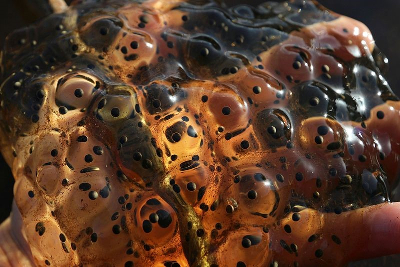
Identifying Amphibian Eggs in the Lowlands of Western Washington
By Chris Byrd
Finding amphibian eggs in your neighborhood ponds and wetlands is an exciting discovery that captures the imagination of kids and adults alike! Learning to identify what species made those egg masses is a fun challenge and the information can be helpful towards local conservation efforts.
Though Chris shares key tips for identifying the egg masses of some common amphibians here in the Pacific Northwest, the information can help you begin to learn what to look for no matter where you live!
The breeding season for amphibians in the lowlands here in Western Washington begins in mid-winter and extends into the spring depending on the temperature and moisture needs of breeding adults.
Adult amphibians breed in areas of still water that contain water long enough for full development of the larval into the adult form.
Movement to breeding areas typically occurs on wet nights with temperatures well-above freezing.
Many amphibians show site fidelity by moving to traditional breeding sites where the individual was born and breeding has been successful in the past. Some individuals will wander and colonize new sites.
Amphibian Eggs: Species Accounts
FROGS:
Northern Red-legged Frog (Rana aurora):
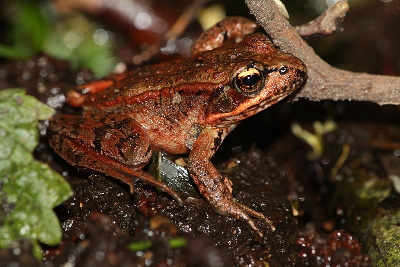 Red-legged Frog
Red-legged FrogNorthern red-legged frogs breed primarily in February and March in the Puget Trough. The breeding behavior of northern red-legged frogs is typical of the genus with males establishing territories in breeding ponds via vocalizations and aggression. Females that enter the pond are grasped in amplexus (see image below) by the male. Fertilization is external as the male emits sperm onto the eggs of the female outside of the female’s body.
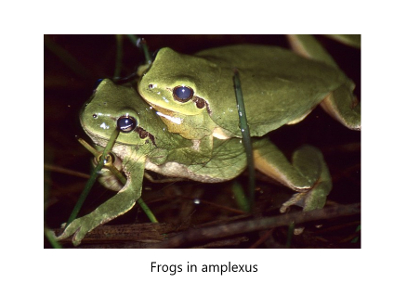
Unlike other Ranid frogs, female red-legged frogs lay their egg masses separate from those of the other females.
Egg masses of red-legged frogs can be identified by the following characteristics:
1) The mass is about the size of a cantaloupe.
2) The mass is soft slipping through the fingers if attempts are made to lift it from the pond.
3) Individual eggs have a wide jelly coat giving the mass the appearance of having fewer eggs for its volume than other species.
4) The mass is usually attached to submerged woody debris or aquatic vegetation.
5) The mass floats to the surface and spreads out near hatching time.
 Red-legged Frog Egg Mass
Red-legged Frog Egg Mass
Oregon Spotted Frog: (Rana pretiosa):
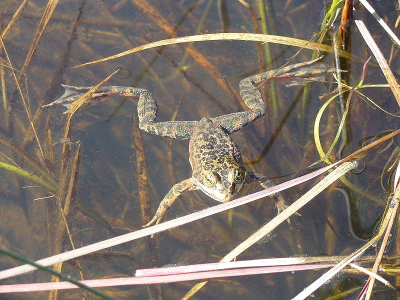 Oregon Spotted Frog
Oregon Spotted FrogOregon spotted frogs breed in February and March in the Puget Sound lowlands. These are highly aquatic frogs. The breeding cycle of spotted frogs follows the pattern of other true frogs.
Egg masses of Oregon spotted frogs can be identified by the following characteristics:
1) The egg masses are similar in size to red-legged frog masses.
2) Eggs are laid in communal masses.
3) Egg masses often with tops above the water-line.
4) There's a thin layer of jelly on individual eggs.
5) Eggs appear tightly packed in the mass .
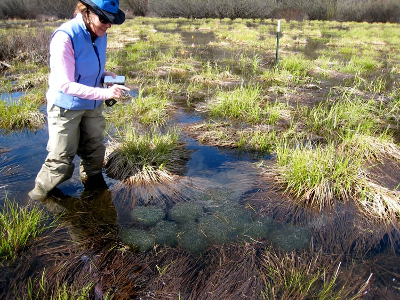 Oregon Spotted Frog Egg Masses
Oregon Spotted Frog Egg Masses
American Bullfrog (Lithobates catesbeianus):
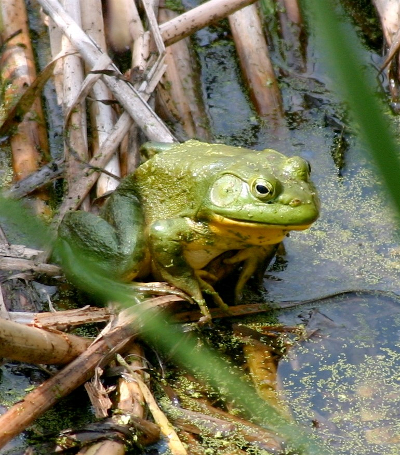 Bullfrog
BullfrogAmerican bullfrogs breed later in the spring as water temperatures increase. Male bullfrogs advertise with a distinct deep “jug-o-rum” call. The rest of the breeding cycle is similar to other frog species in North America.
Egg masses of bullfrogs can be identified by the following characteristics:
1) A sheet of eggs laid on the surface of the water.
2) Egg mass may appear frothy.
3) The eggs are very small.
Be More Prepared For Your Next Outdoor Adventure!

Don't leave home without knowing these six essential survival skills. Our free survival mini guide reveals the strategies of:
- Shelter & fire to prevent the number one cause of death
- Obtaining clean water to avoid life-threatening dehydration
- Common wild survival foods and other critical skills!

Pacific Chorus Frog (Pseudacris regilla): (aka Pacific Tree Frog)
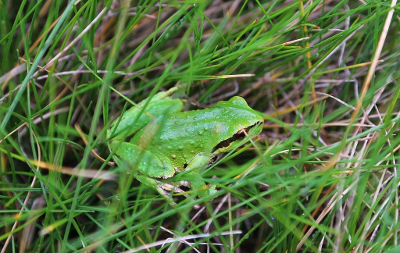 Pacific Chorus Frog
Pacific Chorus FrogThe diphasic “krek-ek” advertising call of male pacific chorus frogs is one of the seminal sounds of the coming spring. Males hold aquatic territories that they defend with physical aggression and vocalizations from other males of the same species.
Females lay their egg masses on aquatic vegetation in shallow still waters. Pacific chorus frogs have fast larval development allowing them to use aquatic habitats that hold water only seasonally.
Egg masses of Pacific chorus frogs can be identified by the following characteristics:
1) Egg masses are oblong in shape.
2) Individual eggs have a thin jelly layer.
3) There are more eggs per unit area than species with similar egg masses.
4) The mass is soft and amorphous when removed from the water.
5) The mass is attached to aquatic vegetation in shallow water.
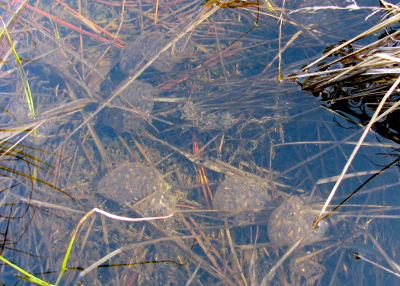 Pacific Chorus Frog Egg Masses
(photo from Oregon Department of Fish & Wildlife)
Pacific Chorus Frog Egg Masses
(photo from Oregon Department of Fish & Wildlife)
SALAMANDERS:
Northwestern salamander (Ambystoma gracile):
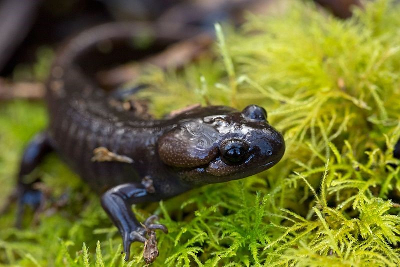 Northwestern Salamander
Northwestern SalamanderNorthwestern salamanders move to breeding ponds in February. Males spend more time in breeding ponds than females. Males leave their spermataphore (containing their sperm) on the bottom of the pond. The female will pick up the spermataphore with her cloaca and store the sperm until eggs are laid.
In the lowlands of Western Washington many northwestern salamanders breed in their larval form.
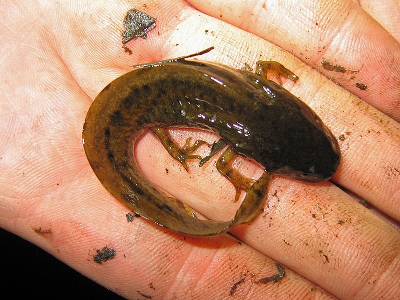 Larval Northwestern Salamander
Larval Northwestern SalamanderEgg masses of northwestern salamanders can be identified by the following characteristics:
1) The egg mass is firm.
2) A second jelly coat gives the egg mass a wavy appearance.
3) Eggs are often laid on submerged woody material.
4) The egg masses have a green coloration due to symbiosis with an algae
Note: Breeding neotenic salamanders (larval) lay eggs that are softer and laid on the bottom of ponds instead of on submerged debris.
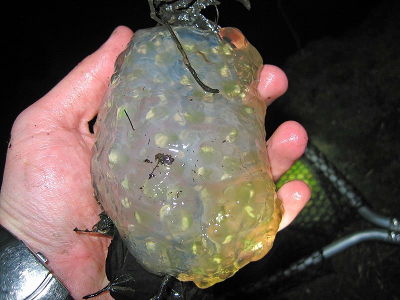 Northwestern Salamander Egg Mass
Northwestern Salamander Egg Mass
Long-toed salamander (Ambystoma macrodactylum):
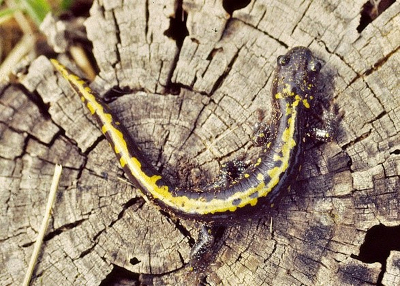 Long-toed Salamander
Long-toed SalamanderThe breeding cycle of the long-toed salamander is similar to that of other salamanders in the Ambystomidae family, such as the northwestern salamander.
Egg masses of long-toed salamanders can be identified by the following characteristics:
1) Eggs are laid in small masses or singly.
2) Egg masses are chicken egg-sized.
3) There is a thick layer of jelly on individual eggs.
4) Eggs look widely spaced within the mass due to the size of each egg.
5) The egg mass is soft.
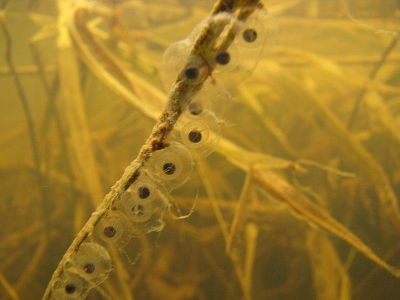 Long-toed Salamander Eggs
Long-toed Salamander Eggs
Rough-skinned Newt (Taricha granulosa):
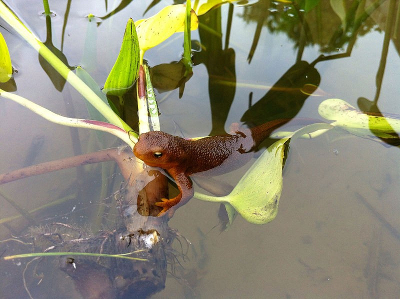 Rough-skinned Newt
Rough-skinned NewtRough-skinned newts can be highly aquatic, sometimes spending most of the year in breeding ponds. Male rough-skinned newts grasp females entering the breeding pond in an amplexus position using both the front and hind limbs. The male then uses its enlarged tail to move her away from other males. Other portions of the breeding cycle are similar to other salamanders.
Egg masses of rough-skinned newts can be identified by the following characteristics:
1) Eggs are laid singly in dense vegetation.
2) Jelly layer is thinner than long-toed salamander eggs.
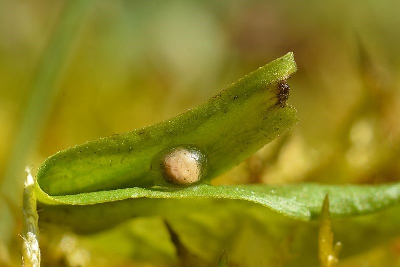 Rough-skinned Newt Egg
Rough-skinned Newt Egg
Amphibian Eggs: Concluding Thoughts
Identifying amphibian eggs can be a valuable addition to many wildlife conservation projects. It can also be a fun springtime activity for the whole family. I hope this article enhances your outdoor adventures!
By the way, when you're spending more time in nature it's important to know how to stay safe in the outdoors, especially if you were to get lost. Right now you can get a free copy of our mini survival guide here, where you'll discover six key strategies for outdoor emergencies, plus often-overlooked survival tips.
Additional Resources on Amphibian Eggs:
Learn more about amphibian eggs at Northwest Trek Wildlife Park

About the Author: Chris Byrd is an instructor at Alderleaf. He has been teaching naturalist skills for over twenty years. Learn more about Chris Byrd.
Return back from Amphibian Eggs back to Wilderness Skills Articles
Is The Essential Wilderness Survival Skills Course Right for You? Take the "Online Survival Training Readiness" Quiz
See for yourself if this eye-opening course is a good fit for you. It takes just a few minutes! Get your Survival Training Readiness Score Now!

Grow Your Outdoor Skills! Get monthly updates on new wilderness skills, upcoming courses, and special opportunities. Join the free Alderleaf eNews and as a welcome gift you'll get a copy of our Mini Survival Guide.

 The Six Keys to Survival: Get a free copy of our survival mini-guide and monthly tips!
The Six Keys to Survival: Get a free copy of our survival mini-guide and monthly tips!
Learn more